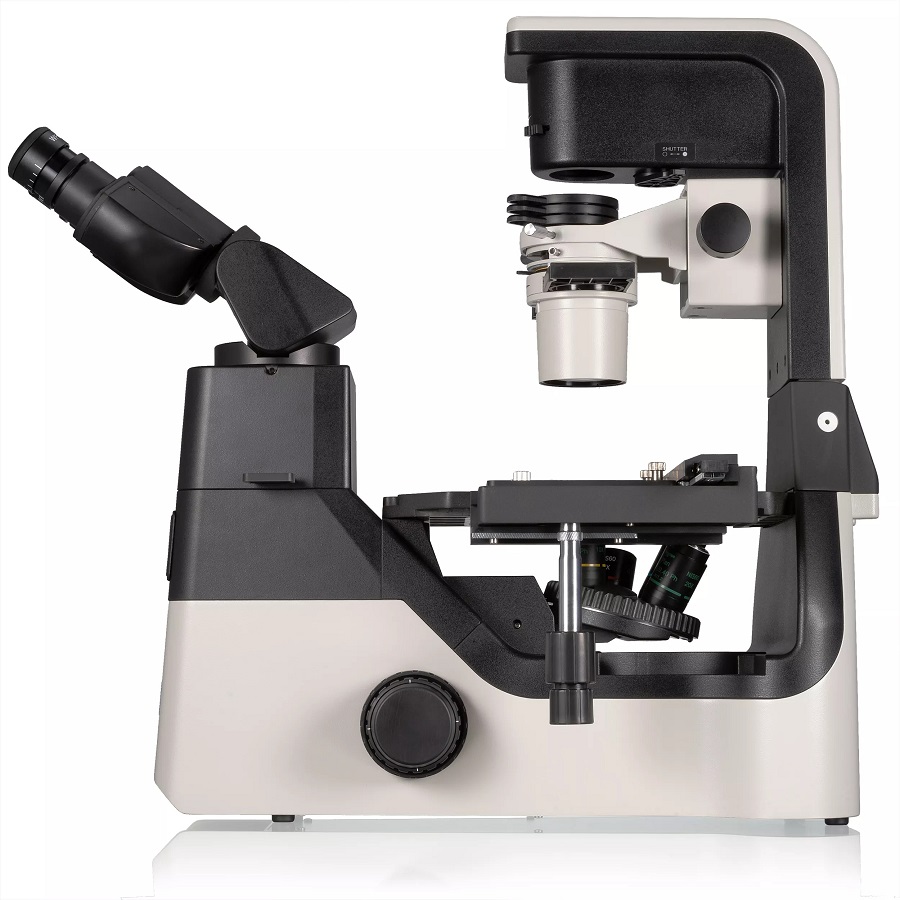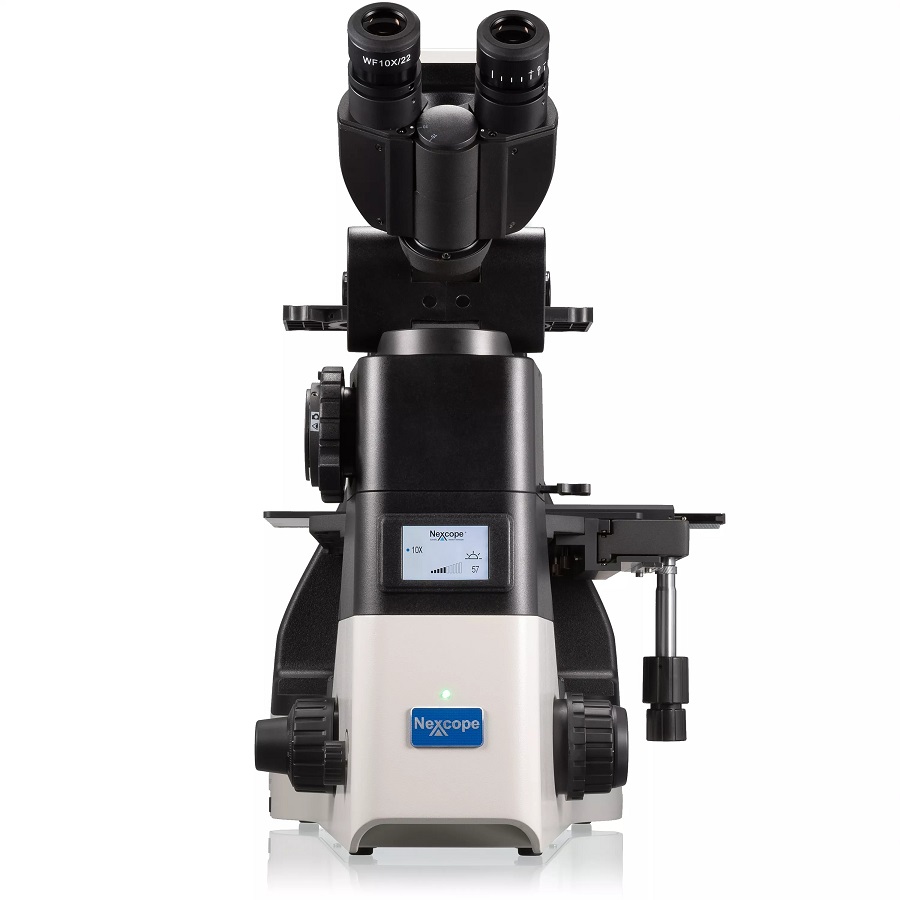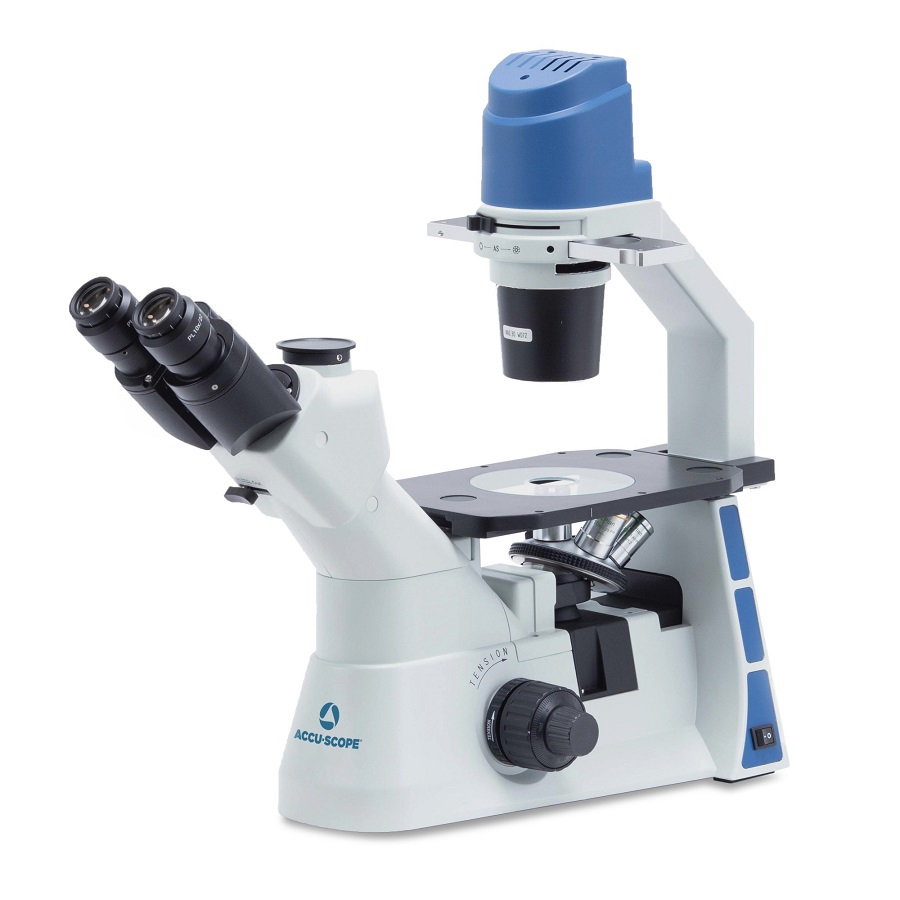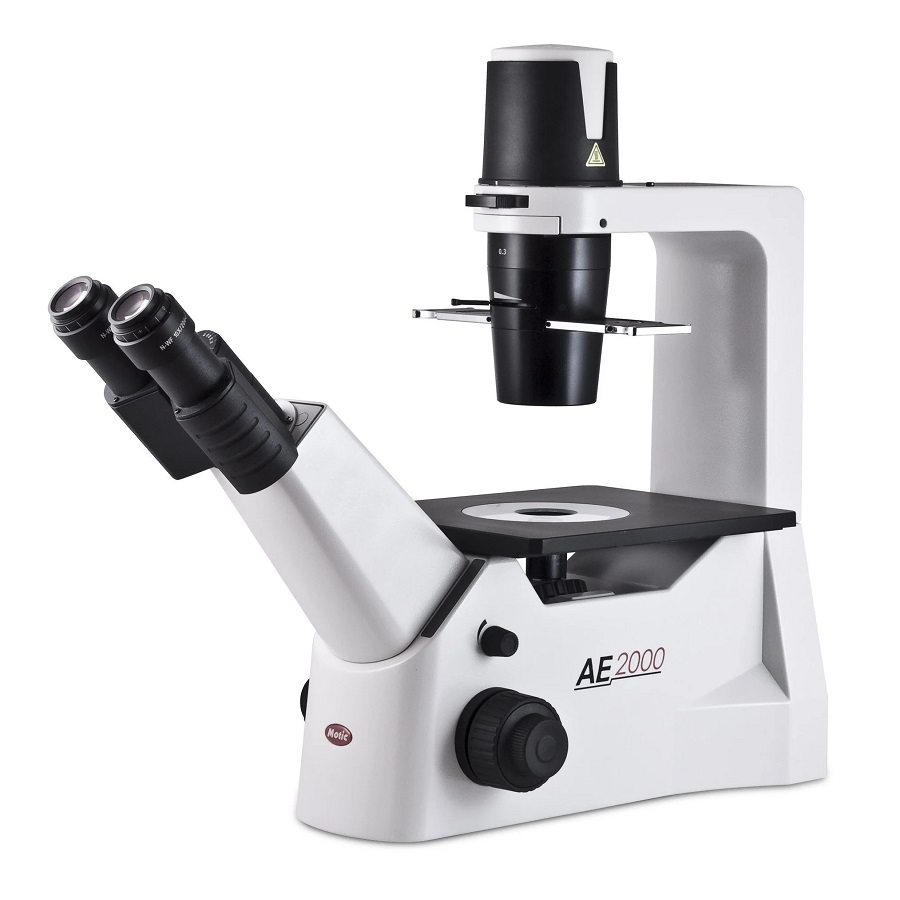Introduction to Inverted Microscopy
Inverted microscopes have revolutionized cellular studies. Unlike traditional microscopes, they observe specimens from below. This design allows researchers to analyze living cells in more natural conditions. The inverted microscope is now a fundamental tool in many biological and medical labs.
Scientists rely on these microscopes for detailed cellular analysis. The ‘inverted’ aspect offers several advantages. It lets scientists use larger dishes for cell cultures. They can track cell growth over time with minimal disturbance. This setup is perfect for observing cells in a more natural, undisturbed state.
Inverted microscopes support various research fields. They are crucial in cancer research, neuroscience, and developmental biology. Understanding how these microscopes function is key. It helps to make the most of their features. These instruments have evolved considerably. They now include enhancements in ergonomics, imaging, and fluorescence techniques.
The integration of artificial intelligence (AI) in microscopy is groundbreaking. It has improved analysis and opened up new research paths. AI aids in pattern recognition and data interpretation. This has been a game-changer in diagnostic and therapeutic strategies.
As technology progresses, so do inverted microscopes. They have become more sophisticated and user-friendly. The future promises even more improvements in functionality and application. Innovations are geared towards automation and higher precision in imaging.
This advancement in technology enhances the capabilities of inverted microscopes. It enables scientists to conduct cutting-edge research. With ongoing developments, the role of inverted microscopes in scientific discovery is more significant than ever. Upcoming sections will delve deeper into these advancements.

Key Features of Modern Inverted Microscopes
The modern inverted microscope has evolved with features that boost research efficiency. Here are key advancements:
- Enhanced Imaging Capabilities: Today’s inverted microscopes offer high-resolution imaging. They allow researchers to see cells in stunning detail.
- Improved User Interface: User experience is a priority. The interfaces are intuitive, simplifying the complex processes involved in microscopy.
- Advanced Objective Lenses: Objective lenses on modern inverted microscopes are superior. They provide clearer images and greater magnification flexibility.
- Live Cell Imaging: Inverted microscopes excel in live cell imaging. This is vital for studying dynamic biological processes as they happen.
- Integrated Measurement Tools: Many models come with built-in tools. These tools measure cell structures without additional equipment.
- Automated Functionality: Users benefit from automated features. They save time and reduce the chances of human error during experiments.
- Compatibility with Diverse Samples: The versatility of modern inverted microscopes is exceptional. They handle a range of sample types and sizes.
- Streamlined Maintenance: Day-to-day upkeep is easier, thanks to simplified designs. This ensures the microscope performs reliably over time.
These features make the inverted microscope a powerful instrument in today’s labs. They provide scientists with the tools needed for cutting-edge research. As developments continue, these microscopes will only grow more essential in scientific exploration.
Innovative Designs in Inverted Microscope Ergonomics
Ergonomic design is crucial for microscope users. It ensures comfort during long hours of research. Modern inverted microscopes boast innovative designs focusing on user comfort. These designs can lead to better results and less strain for scientists.
- Adjustable Components: Users can tailor the microscope to their posture. Features like adjustable eyepieces and stage heights cater to individual needs.
- Reduced Physical Strain: Improved ergonomics minimize risk of neck or back pain. This is thanks to optimal positioning of controls and viewing angles.
- Enhanced Control Layouts: Control buttons and knobs are within easy reach. This layout reduces the need for excessive movement while operating the microscope.
- User-friendly Interfaces: Touchscreens with simple menus make navigation effortless. Scientists can adjust settings quickly, without distraction from their work.
- Comfortable Seating Arrangements: Some microscope designs include seating guidance. This encourages proper posture which can lead to more focused research sessions.
- Lightweight Materials: The use of durable, yet lightweight materials makes handling smoother. It also contributes to the overall comfort of the microscope’s use.
These ergonomic advancements in inverted microscope design enhance research effectiveness. They allow scientists to work for extended periods without discomfort. Such user-centered designs are likely to set the standard for future microscope development. This focus on ergonomics paves the way for more intuitive and accessible research tools in the field of microscopy.

Technological Enhancements in Imaging and Resolution
Great strides in imaging and resolution are hallmarks of modern inverted microscopes. These technological enhancements are core to their evolving functionality. They have greatly expanded the capacity of scientists to study complex biological systems with incredible precision. Here are a few key improvements:
- Higher Resolution: New sensors and digital technologies enable sharper images. This clarity is key for detailed analysis of cells and tissues.
- Advanced Imaging Techniques: Methods like phase contrast and DIC (Differential Interference Contrast) provide depth and detail without staining the sample, which is vital for live cell analysis.
- Improved Depth of Field: Enhanced optics offer a deeper depth of field. Researchers can view thicker specimens without losing focus on the details.
- Faster Frame Rates: With speedier cameras, capturing fast cellular processes is now possible. This allows real-time analysis of dynamic events within cells.
These innovations in imaging and resolution mean that the inverted microscope is not just a tool for viewing, but a powerful instrument for discovery. The better the image quality, the more insights scientists can glean from their experiments. As technology continues to push the boundaries, the inverted microscope remains at the forefront of biological research.
Application of AI in Inverted Microscopy
Artificial Intelligence (AI) is altering how scientists use inverted microscopes. AI-driven tools excel at interpreting complex data. They can swiftly identify patterns invisible to the human eye. This advancement is vital for breakthroughs in medical diagnoses and research. Here’s how AI is applied in inverted microscopy:
- Automated Image Analysis: AI algorithms speed up data processing. They go through thousands of images, spotting crucial details faster than any human.
- Pattern Recognition: AI is excellent at recognizing cell behaviors and changes. This proficiency is key in areas like cancer research where cell dynamics are critical.
- Predictive Modeling: AI can predict cell actions based on past data. Predictions help scientists in planning experiments and understanding cellular mechanisms.
- Enhanced Accuracy: AI minimizes manual errors in cell counting and measurement. Precise results improve the reliability of research outcomes.
- Efficient Workflow: By automating routine tasks, AI frees scientists to focus on complex analysis. This efficiency boosts overall lab productivity.
The integration of AI in inverted microscopes empowers researchers. It transforms vast data sets into comprehensible insights. With AI, inverted microscopes become more than imaging devices. They emerge as advanced tools for discovery and innovation. As AI technology develops, its application in microscopy will surely expand. This will open up new horizons for scientific exploration and understanding.
Advance in Fluorescence Techniques
Recent years have seen major advances in fluorescence techniques in inverted microscopes. These improvements have a profound impact on biological research, offering more nuanced insights into cellular processes. Here are the most notable advancements in fluorescence techniques that have enhanced the capabilities of inverted microscopes:
- Brighter Fluorescence: The use of new dyes and illumination systems has resulted in brighter images. Brighter fluorescence allows for better visibility of cellular structures.
- Longer-Lasting Fluorophores: Fluorophores with longer lifetimes reduce the need for frequent re-staining of specimens. This is critical for long-term observation of living cells.
- Multiple Labeling: Scientists now can tag several proteins or structures within the same cell. This allows simultaneous observation of multiple cellular events.
- FRET (F?rster Resonance Energy Transfer) Technology: FRET detects interactions between proteins. It has become a key tool in understanding complex molecular mechanisms.
- Spectral Imaging: This technique separates different wavelengths. It can decipher various fluorophores’ signals, even if their colors overlap.
- Super-resolution Imaging: Beyond traditional limits, this method distinctly portrays smaller cell structures. Researchers get a closer look at the building blocks of life.
- Time-lapse Fluorescence: Time-lapse imaging tracks changes over time. It unveils the dynamics of cellular processes in great detail.
These advancements boost the inverted microscope’s role as an essential research tool. With more sophisticated fluorescence techniques, studies on cell biology become clearer. This clarity propels scientific knowledge forward, revealing the invisible workings within cells in new and exciting ways.

Integration of Inverted Microscopes in Automated Systems
The integration of inverted microscopes into automated systems has redefined lab workflows. With advanced automation, these microscopes enable consistent and efficient research processes. Here are key ways in which automation is enhancing the use of inverted microscopes:
- High-throughput Screening: Automated inverted microscopes can handle large volumes of samples quickly. They can screen cells at a much faster rate than manual methods.
- Consistent Monitoring: Automation allows for the constant observation of cell cultures. This is crucial for studies that require continuous data collection over long periods.
- Precise Manipulation: Inverted microscopes with robotic arms perform precise tasks. They handle delicate samples with care and consistency, reducing human error.
- Integrated Software: Smart software controls automated systems. It manages tasks like focus, light intensity, and stage movement to optimize the view.
- Remote Operation: Scientists can control automated inverted microscopes remotely. This feature is beneficial for maintaining sterile conditions and conducting experiments from anywhere.
- Data Management: Automated systems efficiently collect and organize data. This simplifies the storage and analysis of vast amounts of research information.
These developments in automation streamline the research process. They enhance the capabilities of the inverted microscope. Scientists can expect more reliable and reproducible results. The integration of inverted microscopes in automated systems marks a significant step in lab technology. It brings us closer to fully autonomous research environments.
Future Trends in Inverted Microscope Development
The future of inverted microscopy is shining bright with prospects of further advancements. Here are some anticipated trends:
- Miniaturization: Efforts to make inverted microscopes more compact are underway. This trend aims to make devices more portable and accessible in various settings.
- Wireless Connectivity: Upcoming models may include wireless capabilities. This will facilitate data transfer and remote access, enhancing collaborative research.
- Increased Automation: We expect a surge in full automation. This will further reduce manual input and streamline research workflows.
- Cloud Integration: Cloud storage and computing could be integrated. This will allow for vast data analytics and sharing across the global scientific community.
- Advanced AI Algorithms: More sophisticated AI tools are likely to emerge. They will handle complex data analysis with even greater precision.
- Enhanced 3D Imaging: Improvements in 3D imaging technology will offer deeper insights. This will be particularly useful in understanding the spatial aspects of cellular structures.
- Nanotechnology Integration: The use of nanotechnology in inverted microscopy is a promising frontier. It will allow scientists to observe cellular events at the molecular level.
- Sustainability Measures: As environmental considerations become more pressing, new inverted microscopes will be designed with sustainability in mind. This includes energy-efficient components and eco-friendly materials.
These trends reflect the continuous evolution of inverted microscopes. Researchers and scientists alike can look forward to tools that further push the boundaries of biological research and discovery.
